The main patron of the cold war
In 1950-s. US forces have launched a number of special programs, the main tasks of which were:
• improving the effectiveness of small arms;
• reducing the number of models of small arms that are in service;
• the creation and adoption of a lighter type of weapon (compared to existing weapons caliber 7,62 mm), with a large ammunition;
• the creation and adoption of an effective weapon-cartridge system.
The implementation of these programs was carried out within the framework of the planned re-equipment of the countries members of the NATO bloc with more effective small arms. The main attention of specialists was directed to the development of a new effective cartridge, the tactical and technical characteristics of which were to meet NATO standards:
600 m distance
• the maximum value of the standard deviation of the vertical and horizontal should not exceed 225 mm (for regular and armor-piercing bullets) and 340 mm (for tracer and other bullets);
• the mid point of contact for cartridges of any type should not deviate vertically more than 300 mm from the midpoint of the main cartridge;
300 m distance
• maximum path elevation no more than 225 mm;
570 m distance
• bullets of a new cartridge (with the exception of tracer) at 21 ° C ambient temperature should pierce through a steel plate 3,5 mm thick from mild steel of SAE 1010 or SAE 1020 types, 55-70 НРС hardness;
• each cartridge must have a muzzle energy not less than 1500 J;
• the cartridge must provide bullets with a speed that meets energy requirements when using bullets of nominal mass;
• The average pressure in the chamber should not exceed 330 MPa at 21 ° C.
National developments of foreign firms caliber cartridges up to 5,56 mm
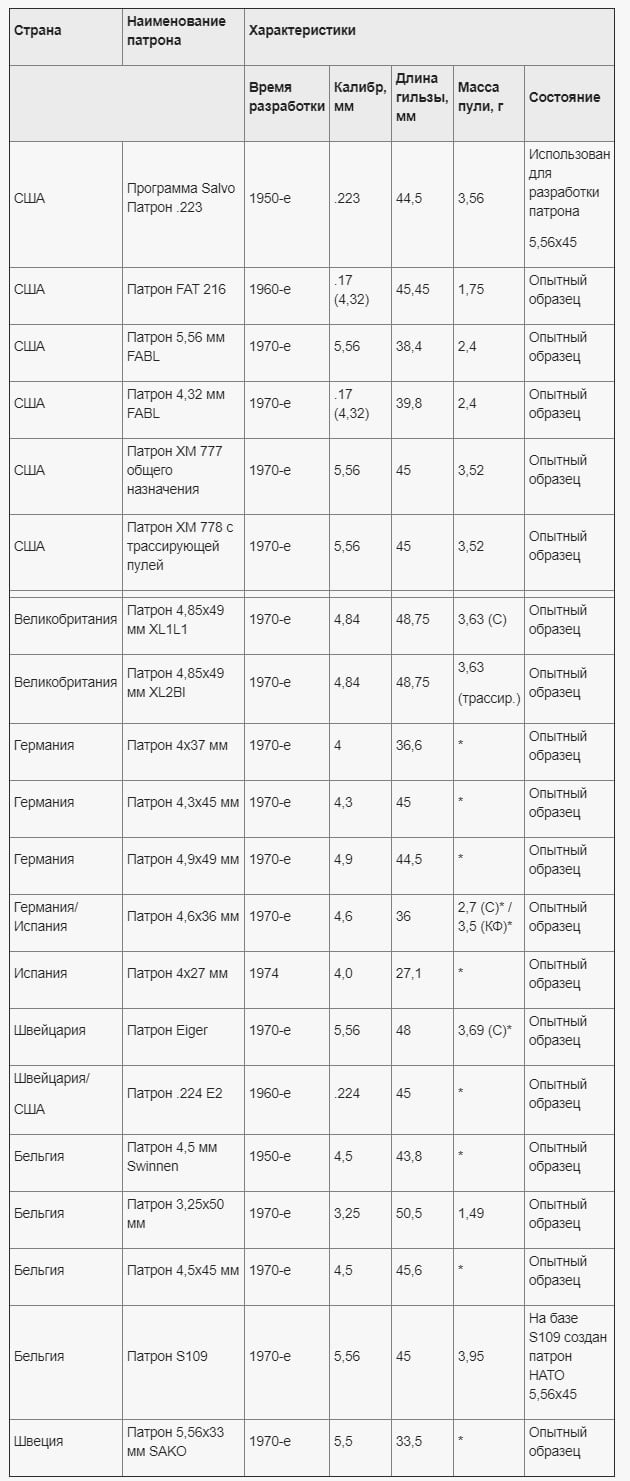
The result of these works was the creation of a new cartridge, which had a great influence on the subsequent development of weapons and ammunition, both in the United States and in other countries. It was a cartridge that is currently known as the NATO 5,56x45 mm cartridge.
It should be noted that the creation of the NATO 5,56X45 mm cartridge was preceded by a series of research projects aimed at creating small-caliber ammunition cartridges up to 5,56 mm, which were carried out by weapons companies of several countries.
Separate characteristics for some of the experienced cartridges developed in the process of R & D, are presented in the table 1.
To confirm the correctness of the choice of cartridge 5,56х45 mm, NATO military experts conducted an analysis of the weapons of soldiers 1950, 1960, 1970 and 1990. the rifle-cartridge small arms system.
The results of the analysis are presented in the table 2.
Comparison of the data shows the undoubted advantage of the rifle - cartridge complex of the 5,56 caliber mm.
Currently, a number of 5,56xXNNUMX mm cartridges, which are manufactured by various companies, have been developed and put into service abroad.
Cartridges 5,56x45 mm are manufactured both in accordance with the NATO-STANAG 4172 standardization agreement, and in accordance with US standards. This is explained by the fact that the cartridges are designed for firing weapons with different pitch cuts: for the NATO 5,56x45 mm cartridge, the thread pitch is 178 mm, and for American-made cartridges, 305 mm. This is due to the fact that for sustaining a heavier bullet of the 5,56x45 mm NATO cartridge, a large rotational speed is required, and for a lighter bullet of the American cartridge, at a high rotational frequency, re-stabilization is observed.
The main tactical and technical characteristics of the 5,56x45 mm NATO cartridge are presented in the 3 table.
Comparison infantry infantrymen 1950, 1960, 1970 and 1990.
The cartridges 5,56x45 mm are:
• cartridge Cartridge 5,56 mm Ball M 193 general purpose;
• Cartridge 5,56 cartridge mm Tracer M 196 with tracer bullet;
• Cartridge 5,56 cartridge mm Rifle Grenade M 195 for firing rifle grenades;
• Cartridge Cartridge 5,56 mm High Pressure Tast M 197 high pressure;
• Cartridge 5,56 training cartridge mm Dummy Field M 199;
• Cartridge 5,56 training cartridge mm Blank 200 mm;
• demo cartridge Cartridge 5,56 mm Dummy Inert M 232;
• cartridge 5,56x45 mm 2300 from Hirtenberger Patronenfabrik (Germany);
• cartridge 5,56x45 mm SS92 of FN (Belgium);
• cartridge 5,56x45 mm SS109 of FN (Belgium);
• cartridge 5,56x45 mm Р112 from FN (Belgium);
• cartridge 5,56Х45 mm L110 from FN (Belgium). Data on the external ballistics of typical 5,56xXNNXX mm rounds are presented in the 45 table.
Data on the hardness of steel cores bullets 5,56 mm are presented in the table 5.
The test results on the accuracy of 5,56 mm cartridges are presented in the table 6.
The US Marine Corps tested the accuracy of the 5,56 mm firing of ammunition for a rifle-cartridge complex.
The tests were used 32 rifles M16A1X1 with pitch 177,8 mm. The shooting was carried out in three series of five shots in each series from the sighting machine at a distance of 85,04 m and in field conditions at a distance from 192 m to 728 m. The tests used the cartridges M193, FN SS 109, XM 855.
The test results for one of the samples are presented in table 8.
The standard 5,56x45 mm US Army cartridge was named Cartridge 5,56 mm Ball M 193 and was adopted by 1961 g. At first it was equipped with 1,62 g of tubular powder, and with 1965 g - 1,74 g of spherical powder. When firing these cartridges from rifles M16 or M16А1, the initial speed was 995 m / s.
The bullet dimensions of this cartridge were: length - 18,9 mm, the length of the leading part - 6 mm, tail length - 2,2 mm. The head part of the bullet has the form of a blunt came to life: radius - 36 mm, diameter of the top - 1,14 mm Depending on the year of manufacture, the bullets differ in the shape and angle of the tail section and the constructive appearance of the shell.
The shell material is tompack, thickness is 0,5 mm, the core is made of lead with the content of 10% antimony. Because of the small radius, the bullets came to life, the distance from the center of gravity to the center of pressure was quite large, which, combined with high speed, makes it possible for the bullet to become unstable when it encounters an obstacle and, especially, when penetrating a soft medium. The bullet has a high lethal effect.
Cartridge Cartridge 5,56 mm Traup М196 with a tracer bullet has a tracing distance of 450 m. The mass of the bullet is 3,4 g, length - 22,3 mm, length of the leading part - 9 mm, radius of the ogival part - 36 mm. Tompak shell 0,5 mm thick contains a lead core, igniter and tracer compositions. The tracer is closed with a white plastic gasket. The tip of a bullet at a length of 6,5 mm has a dark red color (depending on the manufacturer, the tip color may have different shades). Gunpowder tubular, mass 1,65 g, provides speed 980 m / s.
Cartridge Cartridge 5,56 mm Rifle Gremade M195 is designed for firing rifle grenades. The cartridge has an elongated sleeve on the 3 mm, the sleeve is crimped in the form of a star with folds. Cartridge length - 48 mm. The mass of the propellant charge, consisting of disc-shaped powder, is 0,48 g. The top of the cartridge is colored black for the length of 3 mm and a corrugation is applied on the cartridge sleeve at a distance of 7,5 mm. This cartridge is manufactured by Twin Cities arsenal (Twin-Cities). At the bottom of the liner applied stamp TW.
Cartridge High Cartridge 5,56 mm High Pressure Tast M197 has a bullet M197 and a powder charge with a mass of 1,59 g of disc powder. The average gas pressure when using this cartridge is 4,55 bar. The cartridge case is nickel plated, although there are batches of cartridges with cut sleeves. The bullet and bottom of the cartridge case are colored purple-red.
The Cartridge 5,56 training cartridge mm Dummy Field M199 is equipped with a brass sleeve with six longitudinal grooves and a M193 bullet, which is held in the sleeve with a corrugated ring on the sleeve. Cartridge length - 57 mm. In the cartridge there is no primer igniter and pilot hole in the sleeve.
Cartridge 5,56 mm Dummy Inert М232 demonstration cartridges are equipped with an inert substitute for powder charge and correspond to the М193 cartridge by their overall and mass characteristics. The sleeve is painted black. An additional feature of this cartridge is a crimped groove on the cartridge case.
Along with the US firms, the cartridge 5,56x45 mm, corresponding to American standards, manufactures a number of European firms.
The 5,56x45 mm cartridge G2300 from Hertenberger Patronenfabrik (Germany) is equipped with a tracer bullet with an ogival part with a radius of 38,5 mm and a radius of the top - 0,5 mm. The mass of the bullet is 3,6 g, the mass of the powder charge is 1,65 g. There is no knurling on the bullet, and the tracer composition is covered with brass foil 0,114 mm thick. The shell of the bullet is tompac, the top of the bullet is X-colored for the length of 5 and is colored in dark red.
The 5,56x45 mm cartridge SS 92 from FN (Belgium) is equipped with a soft-core bullet, in which the length of the leading part is 4 mm, the length of the cone is 3,2 mm. The mass of the cartridge is 12,1 g, and the mass of the powder charge (spherical powder) is 1,72 g.
Cartridge 5,56x45 mm SS 109 was developed by FN (Belgium), equipped with a SS 109 bullet, which has an ovial part with a radius of 41 mm and a top with a diameter of - 0,5 mm. The bullet core is made of solid steel and has a length of 8 mm and a mass of about 0,648 g. The total length of the bullet is 23,1 mm, the length of the leading part is 8 mm, the length of the cone is 3,7 mm, the mass of the powder charge is 4,02 g, initial speed (of the M1,62А16 rifle) - 1 m / s.
When 178 mm rifling pitch is used, the penetration distance of the US Army helmet is 1300 m, German army helmets are 1150 m. is 305 m. The top of the bullet is green.
The 5,56x45 mm P112 cartridge from FN (Belgium) is equipped with a P112 heavy bullet and is intended to defeat lightly armored targets.
At the 178 mm rifling pitch, the bullet pierces the chromonica-left steel 6 mm thick at a distance of up to 140 m.
The 5,56x45 mm SS 109 cartridge from FN (Belgium) is equipped with a P112 heavy bullet and is intended to defeat lightly armored targets.
At the 178 mm rifling pitch, the bullet pierces a plate of chromium-nickel steel 6 mm thick at a distance of 140 m.
Specifications of some 5,56x45 mm ammunition
The core of solid steel has a length of 13 mm, nose radius - 0,5 mm, bow length - 4,7 mm, weight - 1,28 g.
The bullet has a length of 24 mm, the length of the leading part is 8,5 mm, the length of the cone is 3 mm, the mass is 4 g. The thickness of the bullet shell is 0,5 mm, the top of the bullet is black. The live part and the top of the P112 bullet are identical to the SS 109 bullet.
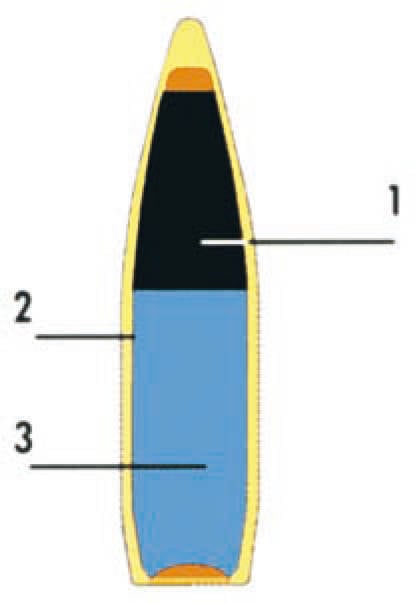
External ballistics of typical combat rifle cartridges
The mass of the powder charge cartridge - 1,72 g, the initial speed (of the rifle M16A1) - 930 m / s.
Cartridge 5,56x45 mm L110 is equipped with a tracer bullet L110, which has a length of 29,25 mm, the length of the leading part - 15 mm; The ogival part of the bullet is similar to the SS 109 bullet. The shell thickness of the bullet - 0,5 mm, the bullet on the 3 mm in length is painted in red. The mass of the powder charge cartridge - 1,62 g, the initial speed 690 m / s.
The trajectory of the L110 bullet at a distance of 600 m almost coincides with the trajectory of the SS 109 bullet. The luminous red trail of a bullet becomes visible in daytime conditions at a range of 15 m, and reaches maximum brightness at a range of 140 m and remains at a distance of up to 800 m.
Some firms in European countries develop and manufacture 5,56x45 mm cartridges in accordance with the NATO-STANAG 4172 standardization agreement, but they do not meet the standards of the US Army.
In their work, these firms go in two directions:
• to find a compromise between the pitch of the trunks in 1 / 7 "and 1 / 12", the companies developed the cartridge 5,56х45 mm for the rifling 1 / 9 ";
• on the basis of the NATO-STANAG 4172 standardization agreement, firms are trying to increase the effectiveness of 5,56x45 mm cartridges, which will allow firing from barrels in increments of both 1 / 7 "and 1 / 12".
For firing weapons in increments of 1 / 9 ", the companies have developed a series of 5,56x45 mm ammunition, which differ in the design of bullets.
The company Hirtenberger Patronenfabrik (Germany) has developed a cartridge 5,56x45 mm with different bullet options:
• cartridge with tracer bullet;
• a cartridge with a bullet having a core of two metals: the front is made of lead, the tail is made of solid steel;
5,56-mm combat ammunition accuracy test results: five consecutive series of 5 rounds per 200 yards (182,9 m)
* The first batches of SS109 cartridges showed lower speeds than the FNB 81 SS109 cartridges tested by the Marine Corps. The average speeds obtained by the Marine Corps when firing with the M16А1Е1 rifle were: - 3079 ft / s (938,5 m / s) - for the SS109 cartridge bullet (FNB 81) - 3191 ft / s (972,6 m / s) - for the patrol bullet М193 (batch TW2-860) - 3120 ft / s (951 m / s) - for the bullet of the cartridge ХМ855 (batch LC 81 Н 300 5162).
Measurement of the hardness of steel cores of 5,56-mm bullets of rifle cartridges
* Samples were cut, fastened with epoxy, polished with a micron 0,3 with alumina and etched. The load on the pyramid 1000 h. The results are average values obtained from three measurements at the tip, at the center of gravity and at the base of the core.
The overall mass characteristics of the cartridges of these models are presented in the table 9.
Bullet Model II provides 80% penetration of steel plate 3,5 mm thick with 108 + 15 HB hardness from SAE 1020 steel at 570 m range, and 10 mm thick plate with 120 HB HB hardness from 10ST 0-I steel at 37 m range.
Hirtenberger Patronenfabrik has also developed a cartridge with three models of G 2300, G 3100 and G 3200 tracer bullets:
• model bullet G 2300 in its parameters meets the requirements of the American standard;
• the G 3100 bullet model has a tracer composition with a low burning rate and provides maximum light intensity at a distance from 120 m to 500 m, the bullet shell is made of bimetal, the top of the bullet is colored red;
• the G 3200 bullet model has equipment similar to the FN L 110 bullet equipped with a tracing distance of about 750 m at the initial speed of 960 + 15 m / s; bullet length - 24,75 mm; weight - 3,42 g; powder charge mass - 1,65 g; bullet shell made of bimetal. The tracer is protected by 0,05 mm thick brass foil. The top of the bullet is painted white.
Mauser-IWK (Germany) has developed a series of significantly improved 5,56x45 mm cartridges equipped with soft and hard core bullets, tracer bullets and training cartridges. Compared to the US, the bullets of these cartridges are longer and are fired from the barrels with the 1 / 7 "and 1 / 9" rifling pitch (American ammunition is fired from the barrels with the 1 / 12 rifling pitch only). deep-drawn sheet metal clad with nickel (Mauser-IWK’s bullet shell is 0,25 mm and M 193 is 0,5 mm).
The soft-core bullet has a mass of 5 g, length - 25,8 mm, length of the leading part — 12 mm, radius of the top — 0,25 mm. The live part is flat and long, there is no tail cone. The mass of the powder charge is 1,63 g. When firing from the barrel length 508 mm, the initial speed is 860 m / s, and the bullet punches the two sides of the helmet at a distance of about 600 m (M 193 - about 400 m).
The solid core bullet has a mass of 4,6 g, length - 22,2 mm, the ogival part of the bullet is similar to the ogival part of a soft-core bullet, the mass of the powder charge of the cartridge - 1,65 g. The core is made of tungsten carbide (diameter - 4 mm, length - 15 mm) and pressed into a lead shirt. The initial speed of the bullet - 890 m / s. At a distance of 100 m at a meeting angle of 40 °, the bullet pierces a steel plate with a thickness of 7 mm.
The results of the test ammunition for accuracy
The tracing bullet has a cylindrical shape, the mass is 3,86 g, the length is 26,4 mm, the mass of the powder charge is 1,65 g, the initial velocity of the bullet is 890 m / s. The length of the luminous trail of a bullet (red) is about 800 m (American bullet - 450 m). The top of the bullet is colored purple.
The company Dynamit Nobel AG (Germany) has developed a training cartridge 5,56x45 mm, the bullet of which consists of a metal case with a through axial bore; the bullet has a detachable plastic top; bullet weight - 2,8 g, length - 21,75 mm (length of the metal part - 15,5 mm), mass of powder charge of the cartridge - 1,39 g.
The company FFV (Sweden) has developed two models of bullets for the cartridge 5,56х45 mm:
• a “humane” soft-core bullet with a dull tip and having a center of gravity, almost coinciding with the center of pressure, as a result, when the bullet penetrates the soft target, the loss of stability begins a few centimeters further; bullet weight - 4,0 g, length - 20 mm, radius of the top - 1,3 mm;
• a bullet with a core of two metals, the mass of the bullet - 4 g.
Societa Metallurgica Italiana (SMI) (Italy) developed a cartridge with a solid-core bullet in a lead shirt having a length of 15 mm and a mass of 1,66 g, bullet length - 22 mm, length of the leading part - 9 mm, weight - 3,3 g, initial speed - 940 m / s. The bullet has a bimetallic shell, the top of the bullet at the length of 5 mm is painted black.
The firm Santa Barbara (Spain) has developed and produces a new cartridge for self-defense weapons in extreme conditions of caliber 5,56x45 mm. Cartridges are also intended for use in guard services. These are shot cartridges with a cylindrical sleeve, having an effective firing range of - 10 m. However, it should be noted that the results of shooting shot cartridges from rifles with rifled barrels are unsatisfactory.
European companies pay particular attention to the development of training (practical) 5,56x45 mm cartridges, which provide soldiers with training in the process of firing without dropping dangerous parts from the barrel. When using a weapon with a muzzle can be fired with practical ammunition in a queue. The range of fragments that are not dangerous to humans is about 3 m.
The company supplies two types of these cartridges: plastic cartridges with a metal bottom and fully plastic cartridges.
Constructive scheme of cartridges and bullets for cartridges:
In accordance with the STANAG 4172 standard, NATO 5,56x45 mm cartridges have a brass sleeve, but firms supply pilot batches of lacquered and phosphated steel cartridges, anodized aluminum and plastic sleeves.
Dimensional mass characteristics of cartridges with different cores Table 9
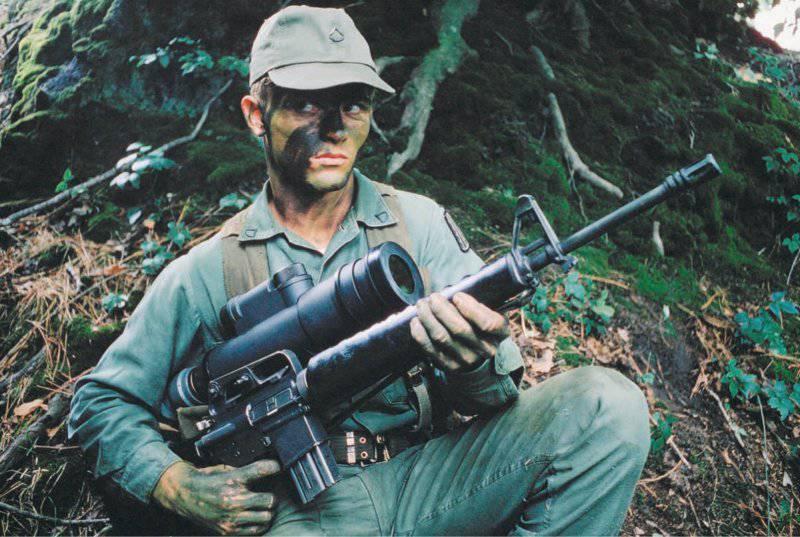

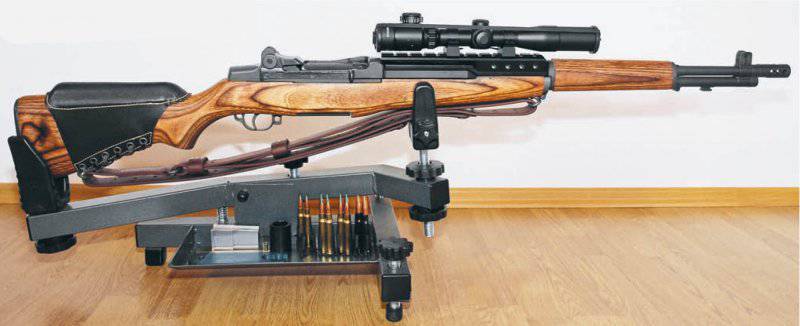
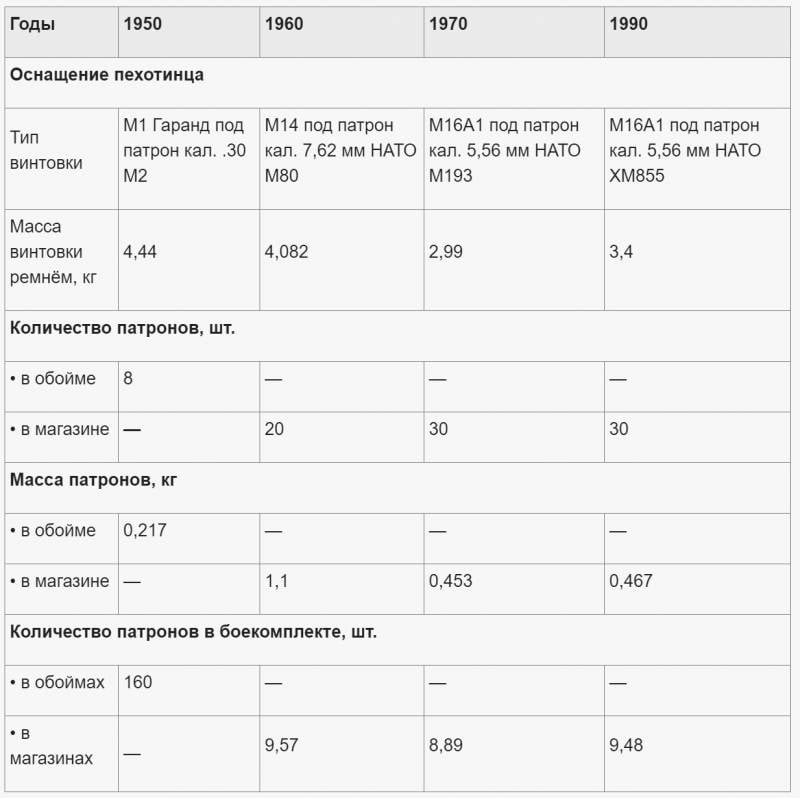

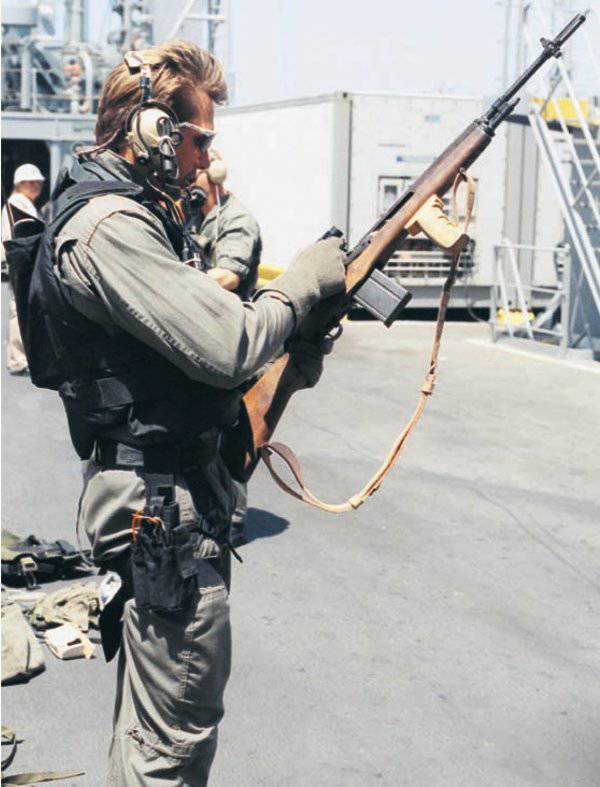

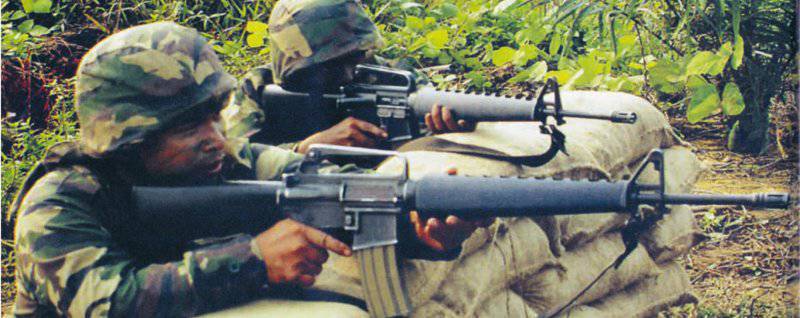
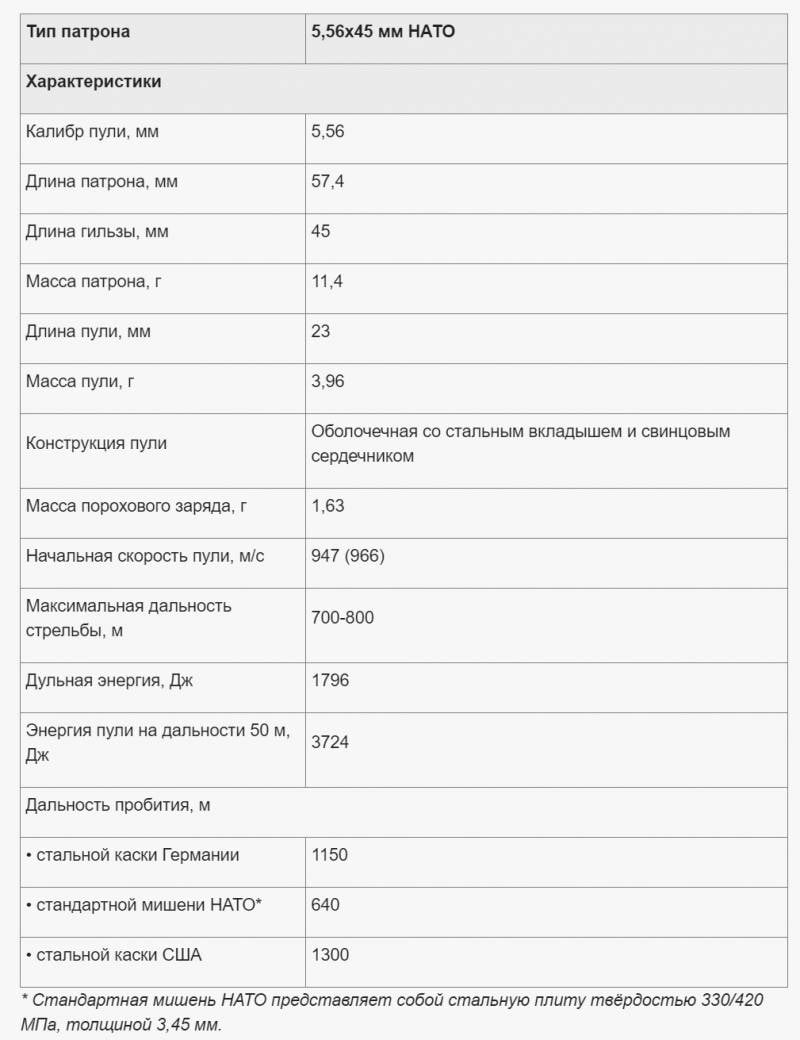
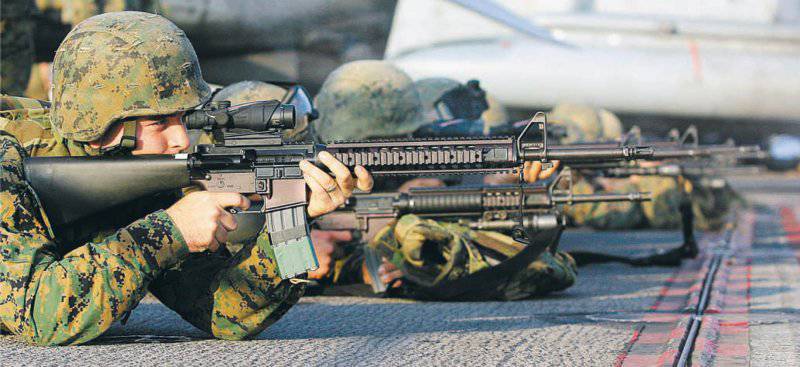
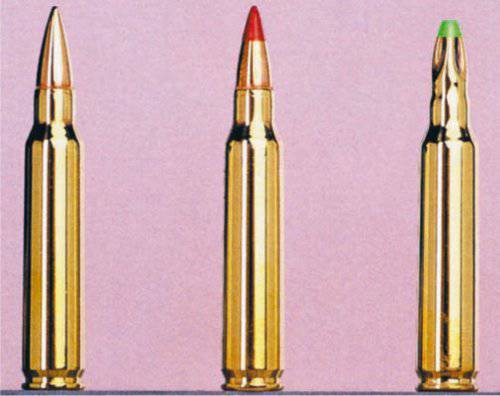
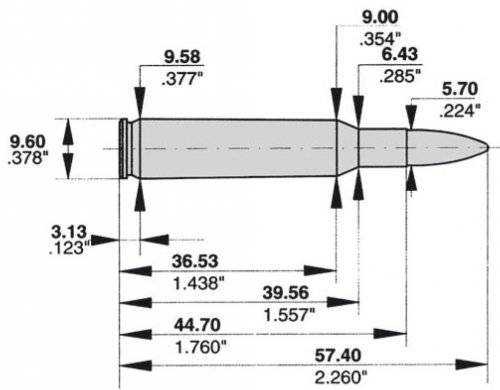
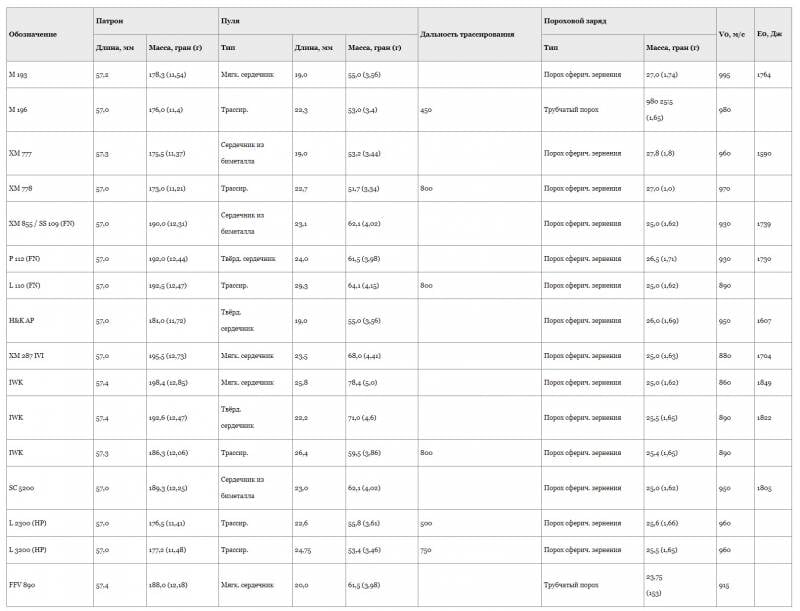
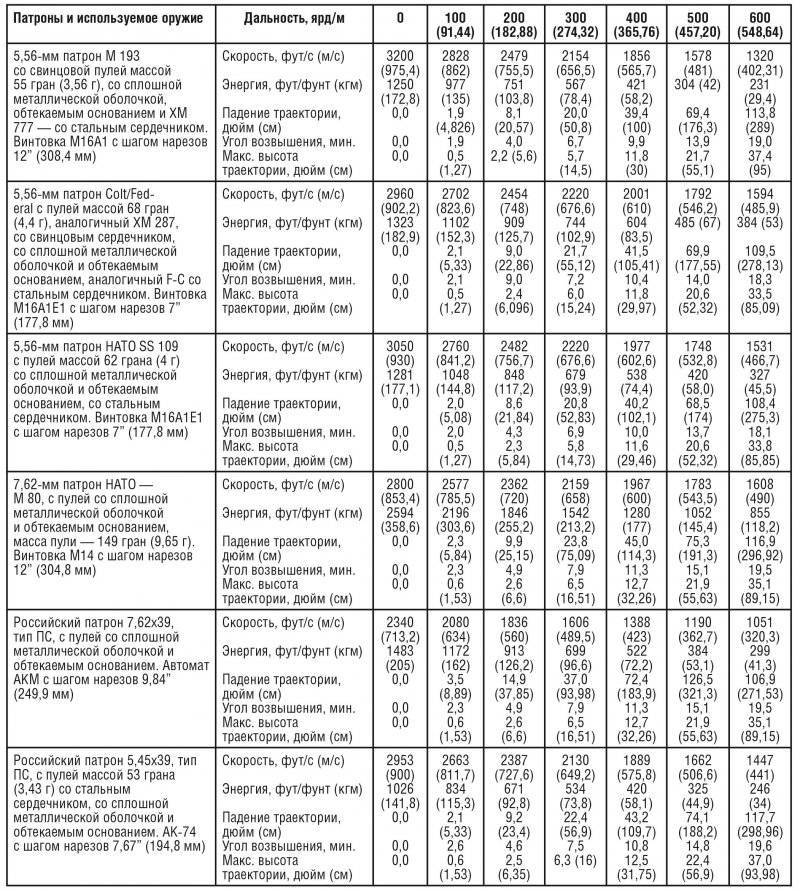
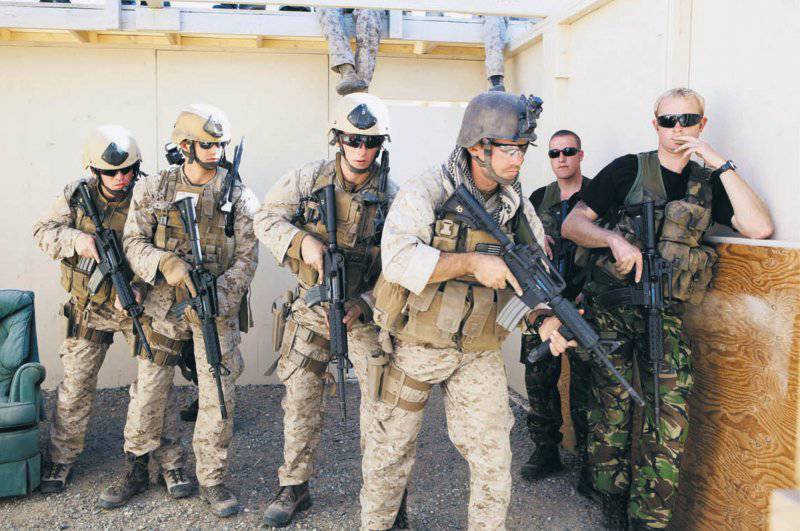
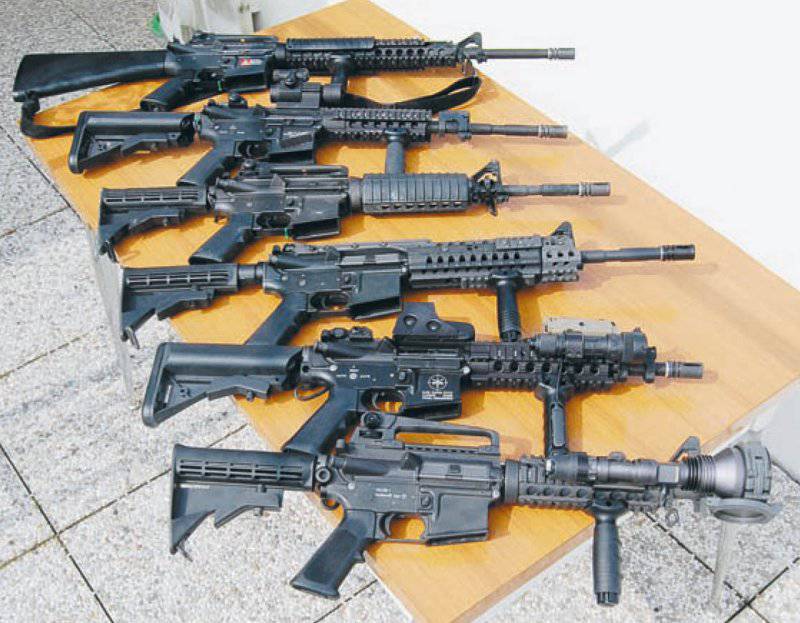
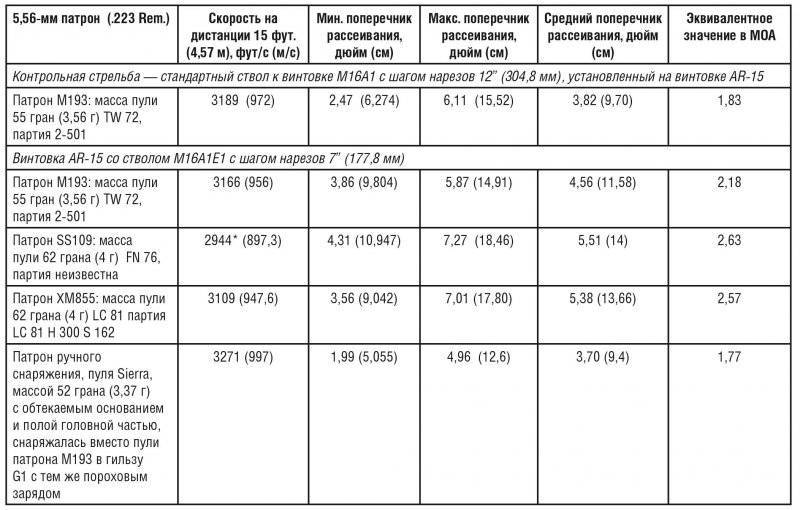
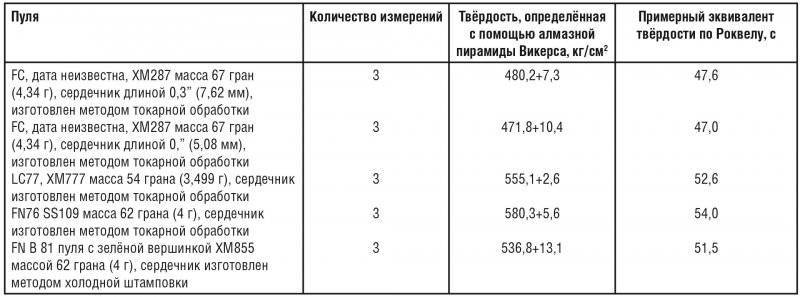
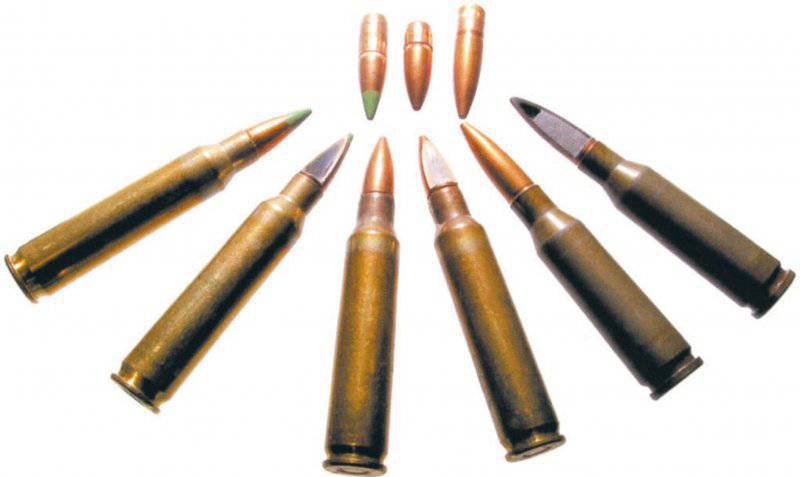
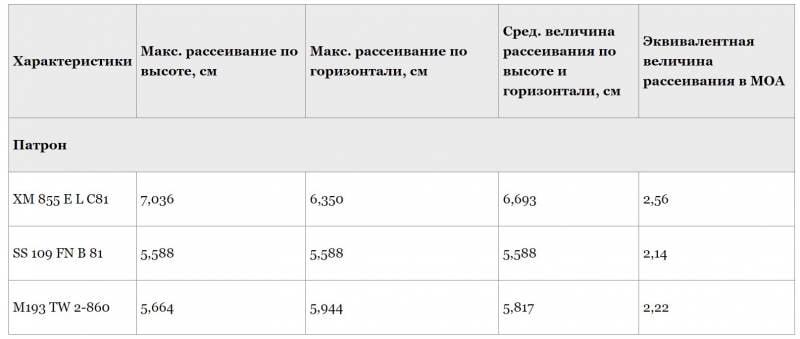
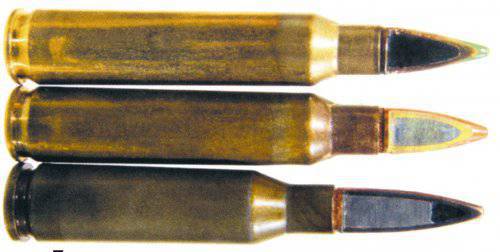
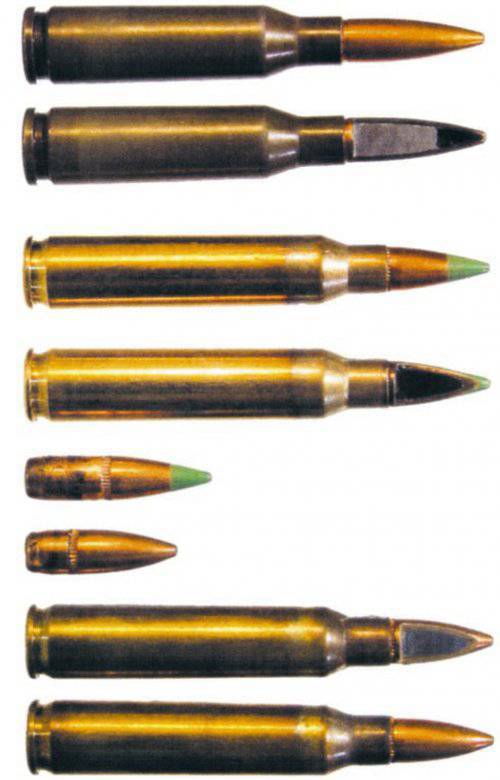
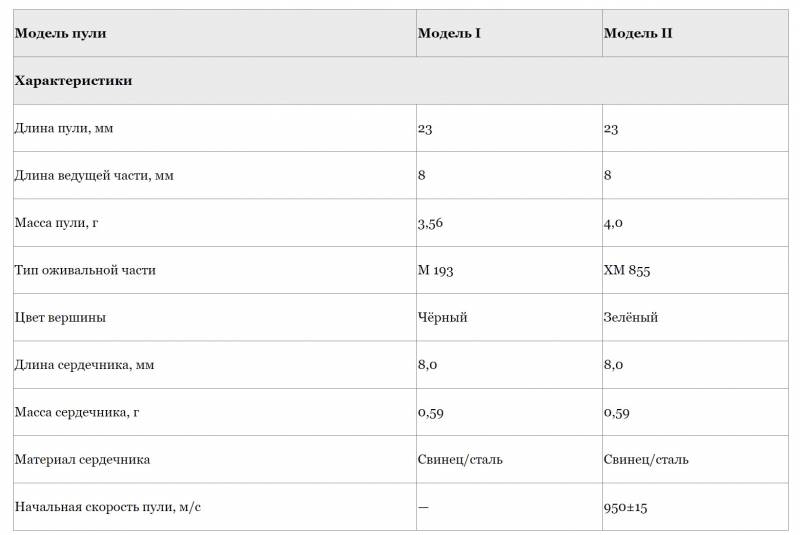
Information